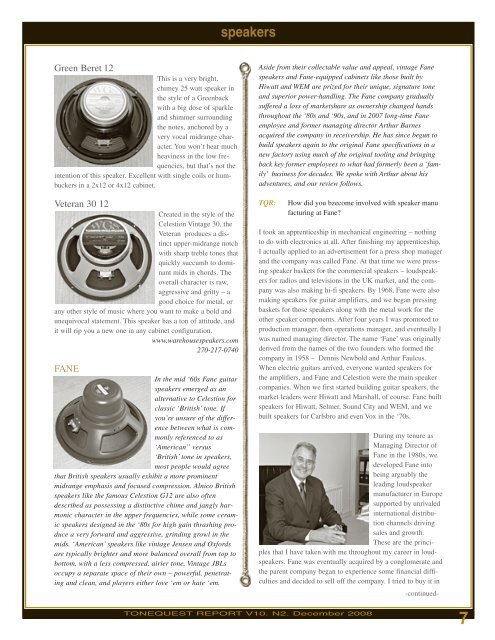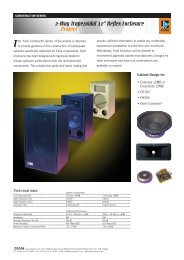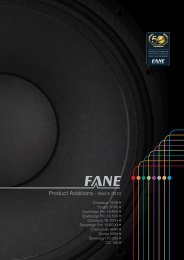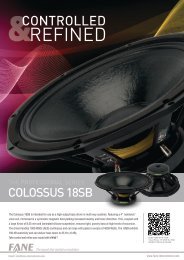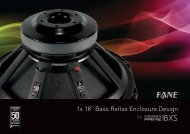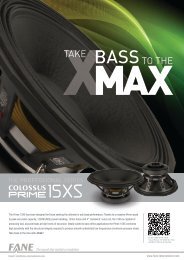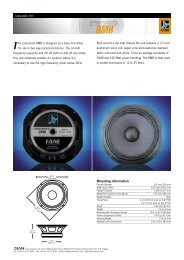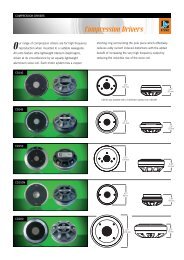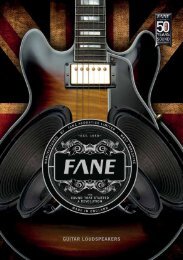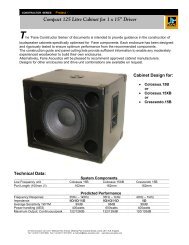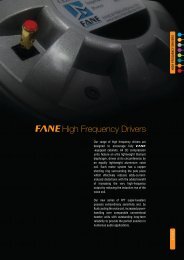speakers - Fane
speakers - Fane
speakers - Fane
- No tags were found...
You also want an ePaper? Increase the reach of your titles
YUMPU automatically turns print PDFs into web optimized ePapers that Google loves.
<strong>speakers</strong>Green Beret 12This is a very bright,chimey 25 watt speaker inthe style of a Greenbackwith a big dose of sparkleand shimmer surroundingthe notes, anchored by avery vocal midrange character.You won’t hear muchheaviness in the low frequencies,but that’s not theintention of this speaker. Excellent with single coils or humbuckersin a 2x12 or 4x12 cabinet.Veteran 30 12Created in the style of theCelestion Vintage 30, theVeteran produces a distinctupper-midrange notchwith sharp treble tones thatquickly succumb to dominantmids in chords. Theoverall character is raw,aggressive and gritty – agood choice for metal, orany other style of music where you want to make a bold andunequivocal statement. This speaker has a ton of attitude, andit will rip you a new one in any cabinet configuration.www.warehouse<strong>speakers</strong>.com270-217-0740FANEIn the mid ‘60s <strong>Fane</strong> guitar<strong>speakers</strong> emerged as analternative to Celestion forclassic ‘British’ tone. Ifyou’re unsure of the differencebetween what is commonlyreferenced to as‘American” versus‘British’ tone in <strong>speakers</strong>,most people would agreethat British <strong>speakers</strong> usually exhibit a more prominentmidrange emphasis and focused compression. Alnico British<strong>speakers</strong> like the famous Celestion G12 are also oftendescribed as possessing a distinctive chime and jangly harmoniccharacter in the upper frequencies, while some ceramic<strong>speakers</strong> designed in the ‘80s for high gain thrashing producea very forward and aggressive, grinding growl in themids. ‘American’ <strong>speakers</strong> like vintage Jensen and Oxfordsare typically brighter and more balanced overall from top tobottom, with a less compressed, airier tone. Vintage JBLsoccupy a separate space of their own – powerful, penetratingand clean, and players either love ‘em or hate ‘em.Aside from their collectable value and appeal, vintage <strong>Fane</strong><strong>speakers</strong> and <strong>Fane</strong>-equipped cabinets like those built byHiwatt and WEM are prized for their unique, signature toneand superior power-handling. The <strong>Fane</strong> company graduallysuffered a loss of marketshare as ownership changed handsthroughout the ‘80s and ‘90s, and in 2007 long-time <strong>Fane</strong>employee and former managing director Arthur Barnesacquired the company in receivership. He has since begun tobuild <strong>speakers</strong> again to the original <strong>Fane</strong> specifications in anew factory using much of the original tooling and bringingback key former employees to what had formerly been a ‘family’business for decades. We spoke with Arthur about hisadventures, and our review follows.TQR:How did you bzecome involved with speaker manufacturing at <strong>Fane</strong>?I took an apprenticeship in mechanical engineering – nothingto do with electronics at all. After finishing my apprenticeship,I actually applied to an advertisement for a press shop managerand the company was called <strong>Fane</strong>. At that time we were pressingspeaker baskets for the commercial <strong>speakers</strong> – loud<strong>speakers</strong>for radios and televisions in the UK market, and the companywas also making hi-fi <strong>speakers</strong>. By 1968, <strong>Fane</strong> were alsomaking <strong>speakers</strong> for guitar amplifiers, and we began pressingbaskets for those <strong>speakers</strong> along with the metal work for theother speaker components. After four years I was promoted toproduction manager, then operations manager, and eventually Iwas named managing director. The name ‘<strong>Fane</strong>’ was originallyderived from the names of the two founders who formed thecompany in 1958 – Dennis Newbold and Arthur Faulcus.When electric guitars arrived, everyone wanted <strong>speakers</strong> forthe amplifiers, and <strong>Fane</strong> and Celestion were the main speakercompanies. When we first started building guitar <strong>speakers</strong>, themarket leaders were Hiwatt and Marshall, of course. <strong>Fane</strong> built<strong>speakers</strong> for Hiwatt, Selmer, Sound City and WEM, and webuilt <strong>speakers</strong> for Carlsbro and even Vox in the ‘70s.During my tenure asManaging Director of<strong>Fane</strong> in the 1980s, wedeveloped <strong>Fane</strong> intobeing arguably theleading loudspeakermanufacturer in Europesupported by unrivaledinternational distributionchannels drivingsales and growth.These are the principlesthat I have taken with me throughout my career in loud<strong>speakers</strong>.<strong>Fane</strong> was eventually acquired by a conglomerate andthe parent company began to experience some financial difficultiesand decided to sell off the company. I tried to buy it in-continued-TONEQUEST REPORT V10. N2. December 20087
<strong>speakers</strong>1989 and failed in that effort,and <strong>Fane</strong> was sold toWharfedale. I left in December1989, and it was to be thebeginning of the end for <strong>Fane</strong>soon after.I then had a conversation withthe founder of Eminence, BobGault, and created Eminence asa branded product for the firsttime. Before that, Eminencewas the world’s number oneBob Gault & Hartley Peavey OEM manufacturer, but withouta brand presence or distribution line of its own. Consequently,it was the loudspeaker industry’s best-kept secret. So I createda product line for my catalogue, supported it with professionalmarketing, which was an exciting development at that time,and established international distribution in all markets outsideNorth America. The international renown of the Eminencebrand today is evidence of the success of this decision.Wharfedale sold <strong>Fane</strong> to another company, it was sold in turnagain, and in February 2007 I was able to buy the business. Ihad also acquired another company called Precision Devices,which makes very high-end PA <strong>speakers</strong>, so we already had asmall manufacturing facility when we acquired <strong>Fane</strong>. The<strong>Fane</strong> factory was located in Leeds, and when we built a newfacility, we were able to bring over all the old tooling andmachinery, and amazingly, many of the original workers. Oneof the smartest moves I made was to find one of my old supervisorsfrom <strong>Fane</strong>, Susan Goodyear, who had begun workingthere in 1978 and whom we hired to run production again.Now, Arthur Faulcus was avery clever fellow, and he hadinvented the glass fiber voicecoil in 1967, which was used inthe guitar <strong>speakers</strong> – copperwire wound on a glass fiberformer, which allowed us todouble the power ratings. Priorto that time, when guitar playerswould play the amplifiers into clipping, the voice coilswould heat up and quickly fail. The glass fiber former morethan doubled the power handling, and it is the same former weuse today. We also have a lady working with us who was acoil winder with <strong>Fane</strong> in 1972, and she is a coil winder for ustoday. In the early days, children would follow their mothersand fathers to work in the business, which was quite common.TQR:To what extent do you feel that the materials usedto manufacture speaker components have changedsignificantly from the old days?Well, as you know, Alnico was exclusively used until itbecame so expensive in the mid ‘60s, and I’d be lying if Isaid it wasn’t challenging to acquire the same high-qualitymaterials today. <strong>Fane</strong> began using Alnico again in the AxiomSeries in the early ‘90s, and we have examples of the olderoriginal <strong>speakers</strong> to compare to. We have retained the samemanufacturing techniques, the same voice coil, and we buythe cones from the same supplier we used in the ‘60s – theBritish manufacturer Kurt Mueller.TQR:Is there an accepted variance in speaker manufacturingspecifications?I would say that a variance of plus or minus 5% in the resonanceof the speaker is a fact of life, but each speaker is testedagainst the master specifications and the response curvemust be within our tolerances.TQR:What do you see as the future for <strong>Fane</strong>?The relaunch of <strong>Fane</strong> is still in the very early stages and wehave a huge number of exciting developments to the productline to unveil over the coming months. We will see a mixtureof our popular favorites standing alongside a raft of newproduct releases which will strengthen and broaden the <strong>Fane</strong>line to an unparalleled extent, giving <strong>Fane</strong> clients the opportunityto use our drivers in every application in a way notavailable to them before. For information on <strong>Fane</strong> <strong>speakers</strong> inthe USA, please reference Tonic Consulting, Inc. in RedwoodCity, CA., www.tonicamps.com, and the <strong>Fane</strong> web site.FANE REVIEWWe received a pair of <strong>Fane</strong> Axiom Alnico 12s and 10s forreview – weighty 34 ounce, 100 watt steel blue Alnicos. Both<strong>speakers</strong> essentially share the same voice – interesting andunique, with stout compression and a very touch-sensitivedynamic character. The <strong>Fane</strong>s avoid sounding aggressive andgritty in the upper mids, retaining a strong midrange focuswithout sacrificing treble presence and sustain. Bass responseis also strong, and the <strong>Fane</strong>s are exceptionally powerful andpunchy. Their overall sound is full, bold and very British,definitely voiced with strong mids, but not at the expense ofclarity. We’re probably just dreaming here, but they remind usa lot of a Hiwatt amp. Mounted as a single or in a 2x12 openback Avatar cabinet, the <strong>Fane</strong> created a fascinating blend oftones capturing both the full fidelity of a classic Fender ampwith the richly focused and lush harmonic detail of a Voxwhen played through our Deluxe and vintage Tremolux amps.Since the frames of the Axiom <strong>speakers</strong> are tapped with onlyfour mounting holes, we were unable to mount the 10 in theblackface Princeton, which still retains its original eightmounting screws. Keep this in mind when considering British<strong>speakers</strong> destined for older combos. We recommend the-continued-8TONEQUEST REPORT V10. N2. December 2008
<strong>speakers</strong><strong>Fane</strong>s for single 10 and 12 configurations (check the numberof screws on your baffleboard and insure that the deep Alnicobell cover will fit), or any extension speaker configuration.<strong>Fane</strong> also offers ceramic models, and additional <strong>speakers</strong>under development.www.fane-international.comTHE EVM12-L CLASSICJoe Bonamassa reminded us ofthe venerable EVM12-L Classicas we were discussing his everchangingrig in the October ‘08issue of TQR. We contacted EV,and they graciously sent us aquad of these magnificent <strong>speakers</strong>to consider on your behalf.We also recalled a story told byStevie Ray Vaughan’s formerguitar tech, René Martinez,about Stevie switching over toEVs after they had become fedup with <strong>speakers</strong> blowing on the road. René and César Diazspent days replacing the baffleboards in Stevie’s Fender ampsand fitting them with heavy duty EVs. One of those EV15swas present in Stevie’s stolen Vibroverb featured in theAugust ‘07 issue of TQR. Aside from the problem that blown<strong>speakers</strong> obviously posed on tour, Stevie was intently focusedon achieving a loud and exceptionally clean tone on stage.The ElectroVoice <strong>speakers</strong> were perfectly suited to handle thepercussive soundpressure created byStevie’s .013-.060strings, multipleamps, Fuzz Face,and his brutalstring-popping‘touch.’ We askedJosh Bartunek,Product Managerfor Bosch Communications Systems to provide some historicalbackground on the EV <strong>speakers</strong>, and we received the followingdescription from an ElectroVoice engineer:“The Electro-Voice EVM12 was originally released to productionin 1973. The EVM12L Series II was released in1978. There is no written history of development – only thefinal documentation and various people’s memories. A varietyof engineers worked on various aspects of the design, so itwould be unfair to single out any specific individuals asresponsible for the EVM12L sound.In the beginning, it was decided that the EVM12L wouldshare the magnet structures and frames of the entire EVMproduct line, much ofwhich would be usedfor sound reinforcementloud<strong>speakers</strong>.Sound reinforcementloud<strong>speakers</strong> musthave high efficiencyand high power handlingto be able toprovide sufficientlyhigh sound pressurelevels in large venues. To meet these requirements, largemagnet structures were designed to create powerful electromagneticmotors for high efficiency. Heavy-duty die-cast aluminumframes were designed to support the large magnetstructures and to ensure that the frames wouldn’t flex duringhigh-power operation. An additional benefit of the large magnetstructures and heavy-duty aluminum frames is that theyact as heat sinks to draw heat away from the voice coil,enabling higher power handling to be achieved. While thesefeatures are essential for sound reinforcement loud<strong>speakers</strong>,they are not commonly found in most guitar <strong>speakers</strong>.Although these design decisions were not originally madespecifically for the EVM12L, they did have an effect on thesonic characteristics and resulted in exceptional reliability.The voice coil, cone, dust dome and spider were, however,specifically chosen for the EVM12L. Although there is norecorded history of the sonic target of the EVM12L, theintent was to make the speaker sound “musical.” The voicecoil was designed to get the ”right amount of distortion”when driven hard. The geometry of the paper cone and thedust dome and the details of the paper pulp were chosen toget “the right sound,” as was the choice for the cloth for thesurround and the treatments applied. Nobody realized at thetime the impact that the EVM12L would have on the futureof guitar sound.For most of its life, the EVM12L speaker was manufacturedat the Electro-Voice facility in Newport, TN. That manufacturingfacility was relocated to Morrilton, AR in 2002 – andthat is where all Electro-Voice loud<strong>speakers</strong> are manufacturedtoday. There have been a variety of changes to the EVM12Lover the years – some intentional and some unintentional.The intentional changes are the obvious cosmetic changes.The frames and magnet structures were redesigned to have amore rounded and sleek look to give the speaker a more modernappearance. These redesign revisions were made tochange the appearance without affect on the performance. Inaddition, a plethora of labels have appeared on the EVM12Lover the years.The unintentional changes to the EVM12L were the result ofchanges in manufacturing processes and materials that-continued-TONEQUEST REPORT V10. N2. December 20089


